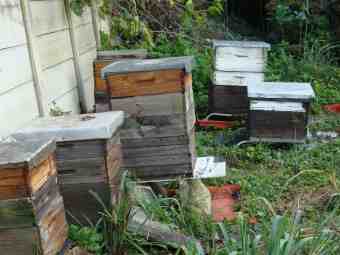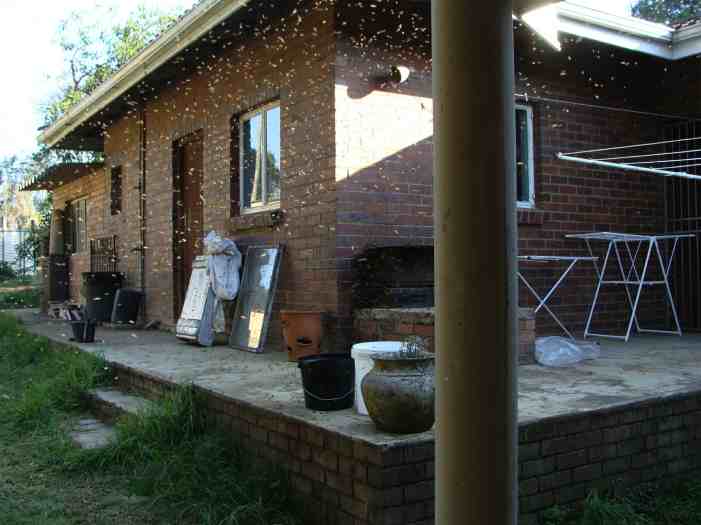- Bernard Preston homepage
- Beekeeping
- Moving Beehives
Moving beehives
Moving beehives requires considerable strength; and at least two people thoroughly clad in protective gear. The critters do not take kindly to being relocated to a new site.
There could be 50,000 or more inhabitants in that hive; each and every one may enthusiastically be trying to end the life of any person who disturbs the peace.
There are any number of reasons why knowledge about moving beehives is important for the apiarist. Perhaps a neighbour was badly stung whilst mowing the grass and demands that you get rid of them; or your child has become allergic to the stings.
Perhaps you are going to move house and want to take the beehives with you.
The reason for this blog is that a feral swarm arrived unexpectedly in a pile of old boxes under the eaves. Every beekeeper has hives lying around; it happens all the time. You either move them that very night to a new location in your apiary or you have to make a plan.
 Are those lids bee-proof?
Are those lids bee-proof?Sound bee-proof hives
If you are moving a strong swarm it is absolutely essential that they are in a sound bee-proof hive; one that you can close up so that none of the little beasties can escape.
So the first step of moving beehives is to check out the condition of the boxes. If any one is not up to scratch then you must begin by shifting them into new accommodation; that is an arduous business in itself but important if they are half-rotten.
First harvest any surplus honey
Honey is heavy stuff; moving a full hive is not recommended. The bees may suffocate and the keeper is likely to slip a disc; first harvest any surplus. In fact if possible remove one or more supers.
If it is during a honey-flow then it's best to harvest as much as possible; make the hive lighter.
Secondly prepare the new site
It's important to prepare the new site in advance. Know the layout before you approach, placing hive-stands in their correct positions; ready for your arrival in the dark.
Secure the hive
It is best to secure the hive either with strapping or short strips of wood, screwed across the different sections; especially the bottom-board. Don't use nails; the hammering will alarm the bees.
It has happened to me on numerous occasions whilst learning the art of beekeeping that one section of the hive comes adrift in transit and the very angry inhabitants come pouring out. Being properly clad during the operation is vital; otherwise you may literally take several hundred stings.
Block up the entrance
I am assuming you are moving the hives around the corner; if it's to California to pollinate the almonds then there is a whole different procedure.
As an aside if there were no beekeepers in America we would also not have any almonds; and a lot of other foodstuffs. One in four mouthfuls that we eat has to be pollinated by our little friends.
Lightly smoke the entrance to the hive to chase any guards and then fit a piece of foam snugly into place.
Not one bee should be able to escape though you must assume that many could in transit; it happens.
That foam must be able to breathe. Insects need air, same as we do. For a short distance a roll of newspaper is adequate.
Two people
It is essential that you have at least two people, properly clad. On more than one occasion during my sixty years of beekeeping a hive has been dropped with disastrous consequences.
With one person on each side, carefully lift the hive and place it on a wheelbarrow. I do not recommend carrying the boxes in the dark; it's not uncommon for a beekeeper to slip or fall on uneven ground. You may injure your spine.
Many beekeepers that I know have had back operations. Don't carry heavy hives any distance; and never on your own.
A third person also fully clad as the bees will fly to a lamp is very useful; carrying a torch to light the whole operation. In fact moving hives is best done at dusk taking alternate boxes; late returnees will find their way safely into a neighbouring colony if they are loaded with nectar.
One person shifts the wheelbarrow, the second steadying the hive. It is top-heavy and may easily topple over.
Place the beehives on a truck
Place the beehives snugly on a truck, strapping them if necessary. Drive slowly and carefully over any rough terrain. Sudden braking could have disastrous consequences.
Feral swarms

The reason for this short essay was the arrival of a feral swarm that moved into one of those empty boxes seven weeks ago. There were no frames. First they needed to be properly hived with drawn comb.
Best in fact is to steal two frames of brood from another colony, one with open young larvae and another fully-capped; and a third with some honey.
Ensure there is some pollen and honey; alternatively you must feed them unless, as often is the case, the swarm arrives in the middle of the flow.
Secure the hive properly; no bees should be able to escape in transit.
How far must you move them?
Folklore is that you must move them at least a mile away. I find that is not adequate and some of the field bees will return to the old place where the hive was located. I shifted mine five kilometres; not one worker found her way back.
How long before you bring them back?
After six weeks you can bring them back safely to the apiary in your garden; not one bee returned to the original site under the eaves.
You really do need two people to move the hive. In this instance after five weeks I checked the colony; they covered seven frames. All was well and I thought I could lift the box with ease in another few days' time.
In just one week an incredible honey-flow began. I had great difficulty lifting the hive; it weighed a ton and I strained my back.
Tomorrow I must harvest all that honey in the broodchamber; and place on a new super with full foundation wax. We are in the middle of a flow so I can safely harvest every available drop.
Here's an update; I harvested 15 bottles of the very best honey yesterday from that little hive, each weighing 500g. It is less than two months since they arrived. Now they must get a super; and probably a second before long.
On average my hives each produce about 70 bottles of honey per annum; and it's as good as you will find anywhere in the world.
Never assume that moving a beehive will be simple; frequently stuff can and does go wrong with serious consequences. I will consult my DC tomorrow and have to be very careful with my lower back for a few weeks.
Moving beehives
Moving beehives is a dangerous business; they are very heavy.
When browsing use right click and "Open Link in New Tab" or you may get a bad gateway signal.
Keep this in mind
Keep this in mind when moving beehives; how do the stingers actually work?
Newsletter
Our newsletter is entitled "create a cyan zone" at your home, preserving both yourself and Mother Earth for future generations; and the family too, of course. We promise not to spam you with daily emails promoting various products. You may get an occasional nudge to buy one of my books.
Here are the back issues.
- Lifestyle and ideal body weight
- What are ultra-processed foods?
- Investing in long-term health
- Diseases from plastic exposure
- Intensive lifestyle management for obesity has limited value
- A world largely devoid of Parkinson's Disease
- The impact of friendly bacteria in the tum on the prevention of cancer
- There's a hole in the bucket
- Everyone is talking about weight loss drugs
- Pull the sweet tooth
- If you suffer from heartburn plant a susu
- Refined maize meal and stunting
- Should agriculture and industry get priority for water and electricity?
- Nature is calling
- Mill your own flour
- Bake your own sourdough bread
- Microplastics from our water
- Alternative types of water storage
- Wear your clothes out
- Comfort foods
- Create a bee-friendly environment
- Go to bed slightly hungry
- Keep bees
- Blue zone folk are religious
- Reduce plastic waste
- Family is important
- What can go in compost?
- Grow broad beans for longevity
- Harvest and store sunshine
- Blue zone exercise
- Harvest and store your rainwater
- Create a cyan zone at your home
Did you find this page interesting? How about forwarding it to a friendly book or food junkie? Better still, a social media tick would help.
- Bernard Preston homepage
- Beekeeping
- Moving Beehives
Address:
56 Groenekloof Rd,
Hilton, KZN
South Africa
Website:
https://www.bernard-preston.com